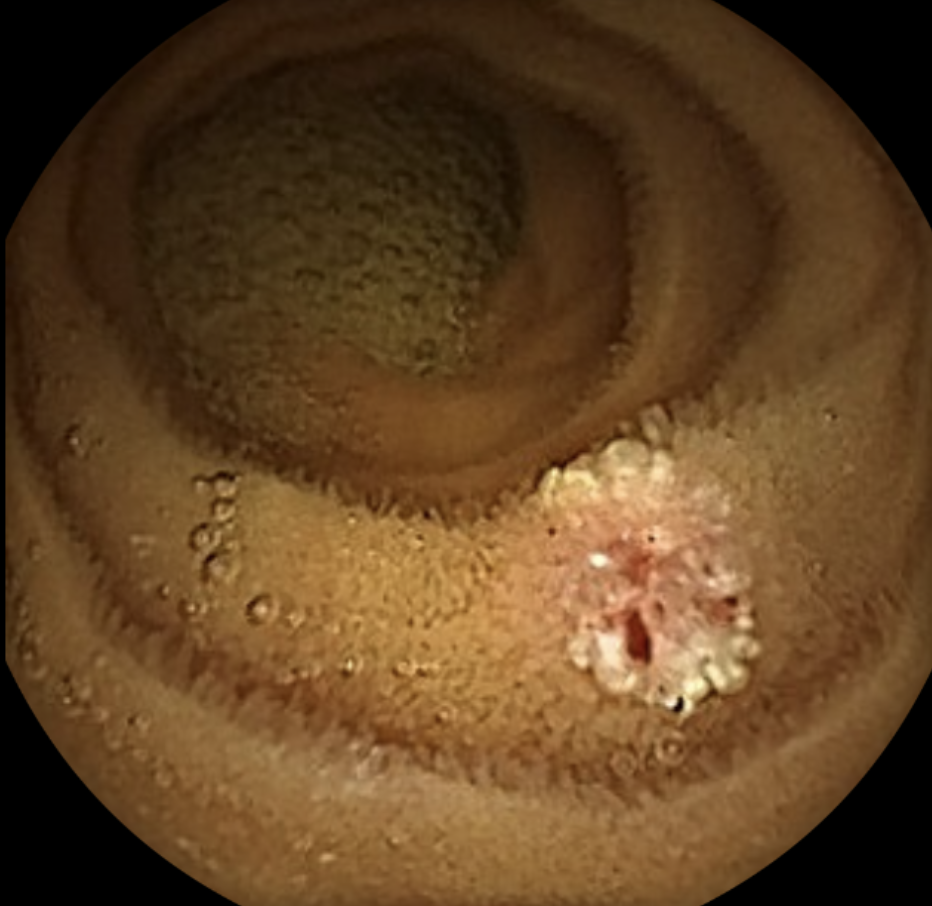Tuesday Poster Session
Category: GI Bleeding
P5241 - Iron Deficiency Anemia Resulting From Hemorrhagic Intestinal Lymphangiectasia
Tuesday, October 28, 2025
10:30 AM - 4:00 PM PDT
Location: Exhibit Hall
- SD
Sue Dong, MD
The Brooklyn Hospital Center, NY
Presenting Author(s)
Sue Dong, MD, Oleksandr Shumeiko, MD, Denzil Etienne, MD
The Brooklyn Hospital Center, Brooklyn, NY
Introduction: Primary intestinal lymphangiectasia, also known as Waldmann disease, is a rare congenital disease typically diagnosed early in childhood. Individuals are usually symptomatic with chronic diarrhea and protein loss attributed to intestinal leakage of lymphatic fluid. In contrast, intestinal lymphangiectasias in the older population often present with no symptoms and are incidental findings on endoscopy. Only a handful of cases of overt gastrointestinal bleeding from lymphangiectasias have previously been described. We report here a case of occult gastrointestinal bleeding arising from a hemorrhagic jejunal lymphangiectasia identified on capsule endoscopy.
Case Description/
Methods: A 61-year-old man with a history of hyperlipidemia was referred to the gastroenterology clinic for evaluation of iron deficiency anemia. Laboratory testing showed a microcytic anemia with a hemoglobin nadir of 8.8 g/dL and a ferritin level of 8 ng/mL, consistent with iron deficiency. He underwent upper endoscopy which demonstrated mild gastritis and duodenitis, and gastric biopsies were positive for Helicobacter pylori. Colonoscopy identified three sub-centimeter polyps, which were resected. He completed treatment for H. pylori infection and continued to have iron deficiency anemia. Subsequent capsule endoscopy revealed two white nodular lesions in the jejunum, one of which exhibited stigmata of recent hemorrhage (Figure 1). The endoscopic appearance of these lesions was consistent with intestinal lymphangiectasias. No additional sources of gastrointestinal bleeding or other suspicious lesions were detected. The patient is planned for small bowel enteroscopy for further management.
Discussion: Bleeding intestinal lymphangiectasia is a rare clinical entity but should be considered in cases of obscure gastrointestinal bleeding and unexplained iron deficiency anemia. Only sporadic reports of bleeding intestinal lymphangiectasias have previously been published. One case was successfully treated with endoscopic band ligation and a few severe cases necessitated surgical resection for definitive management. With increasing application of capsule endoscopy, we expect that this important differential for iron deficiency anemia will be identified more frequently in the future.

Figure: Figure 1: Jejunal lymphangiectasia with stigmata of recent hemorrhage
Disclosures:
Sue Dong indicated no relevant financial relationships.
Oleksandr Shumeiko indicated no relevant financial relationships.
Denzil Etienne indicated no relevant financial relationships.
Sue Dong, MD, Oleksandr Shumeiko, MD, Denzil Etienne, MD. P5241 - Iron Deficiency Anemia Resulting From Hemorrhagic Intestinal Lymphangiectasia, ACG 2025 Annual Scientific Meeting Abstracts. Phoenix, AZ: American College of Gastroenterology.
The Brooklyn Hospital Center, Brooklyn, NY
Introduction: Primary intestinal lymphangiectasia, also known as Waldmann disease, is a rare congenital disease typically diagnosed early in childhood. Individuals are usually symptomatic with chronic diarrhea and protein loss attributed to intestinal leakage of lymphatic fluid. In contrast, intestinal lymphangiectasias in the older population often present with no symptoms and are incidental findings on endoscopy. Only a handful of cases of overt gastrointestinal bleeding from lymphangiectasias have previously been described. We report here a case of occult gastrointestinal bleeding arising from a hemorrhagic jejunal lymphangiectasia identified on capsule endoscopy.
Case Description/
Methods: A 61-year-old man with a history of hyperlipidemia was referred to the gastroenterology clinic for evaluation of iron deficiency anemia. Laboratory testing showed a microcytic anemia with a hemoglobin nadir of 8.8 g/dL and a ferritin level of 8 ng/mL, consistent with iron deficiency. He underwent upper endoscopy which demonstrated mild gastritis and duodenitis, and gastric biopsies were positive for Helicobacter pylori. Colonoscopy identified three sub-centimeter polyps, which were resected. He completed treatment for H. pylori infection and continued to have iron deficiency anemia. Subsequent capsule endoscopy revealed two white nodular lesions in the jejunum, one of which exhibited stigmata of recent hemorrhage (Figure 1). The endoscopic appearance of these lesions was consistent with intestinal lymphangiectasias. No additional sources of gastrointestinal bleeding or other suspicious lesions were detected. The patient is planned for small bowel enteroscopy for further management.
Discussion: Bleeding intestinal lymphangiectasia is a rare clinical entity but should be considered in cases of obscure gastrointestinal bleeding and unexplained iron deficiency anemia. Only sporadic reports of bleeding intestinal lymphangiectasias have previously been published. One case was successfully treated with endoscopic band ligation and a few severe cases necessitated surgical resection for definitive management. With increasing application of capsule endoscopy, we expect that this important differential for iron deficiency anemia will be identified more frequently in the future.

Figure: Figure 1: Jejunal lymphangiectasia with stigmata of recent hemorrhage
Disclosures:
Sue Dong indicated no relevant financial relationships.
Oleksandr Shumeiko indicated no relevant financial relationships.
Denzil Etienne indicated no relevant financial relationships.
Sue Dong, MD, Oleksandr Shumeiko, MD, Denzil Etienne, MD. P5241 - Iron Deficiency Anemia Resulting From Hemorrhagic Intestinal Lymphangiectasia, ACG 2025 Annual Scientific Meeting Abstracts. Phoenix, AZ: American College of Gastroenterology.
